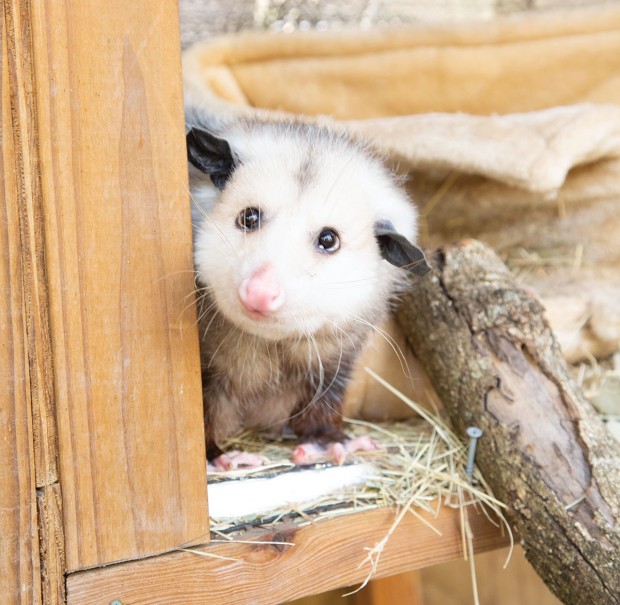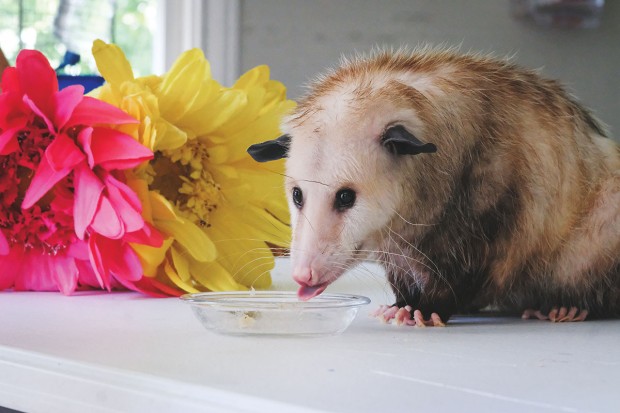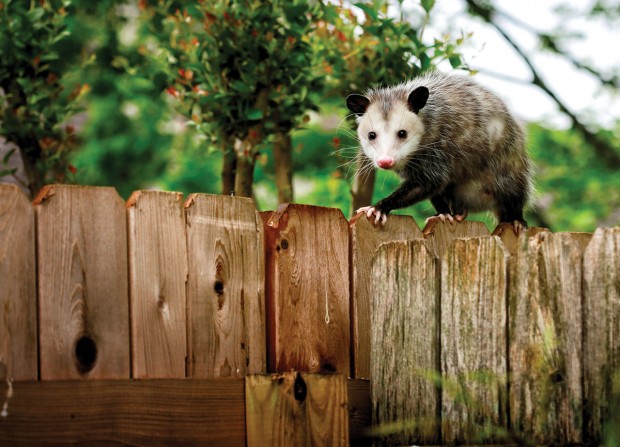Awesome Opossums
They’re everywhere

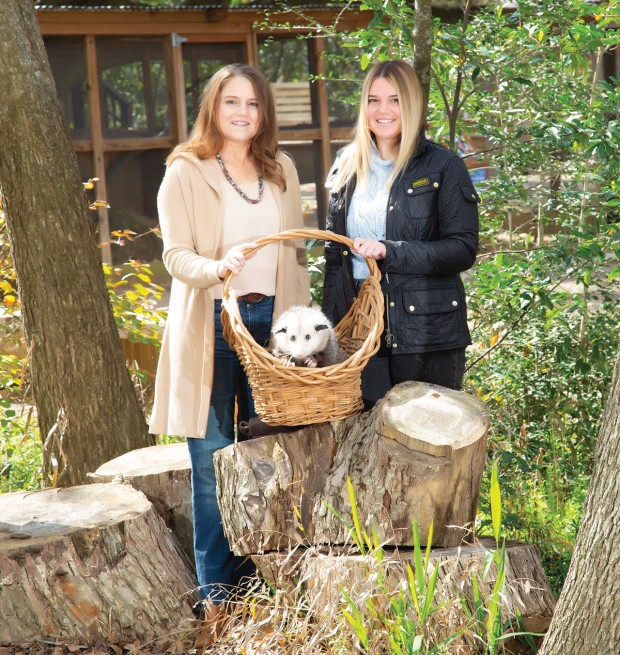
GOOD SPORTS What a difference how and where you meet an opossum makes. From left: Emily and daughter Reese Barrett were startled when an opossum showed up in their living room one night, but recently agreed to pose with Blossom the Opossum at the Nature Discovery Center in Bellaire. (Photo: lawellphoto.com)
On the evening of Friday, October 25th, 2019, the Barrett family was watching the Astros play the Washington Nationals in Game Three of the World Series on television. The lights in the room were dimmed.
One of their dogs, a black Lab, came in with what they thought was a toy … at least until they heard the thud when she dropped it at their feet.
It was what seemed to be a dead opossum.
“My daughter and I jumped up onto the couch, screaming,” remembers Emily Barrett.
And then the opossum scurried away.
Emily turned to her neighbors, via the Facebook group West University Information Exchange, for help.
“Anyone know of a pest control company that will come out NOW?” she wrote.
And thus began what was soon dubbed “PossumGate,” with its own hashtags, #savepete (as the opossum was quickly named by commenters) and #rescueemily. The thread eventually had over 300 comments.
“I would have moved out by now,” said one.
“I. Can’t. Even.” posted another.
Richard Beck suggested using a flashlight to peer under the couch.
“Um. Nope. Not doing that,” replied Emily.
Beck, who had never met the Barretts, remembered he had a Havahart humane animal trap in his garage. After the game, he and his wife brought it over.
“They were so nice,” says Emily.
The Barretts and the Becks set the trap with peanut butter. Thinking quickly, the Barretts also set their Ring security cameras on the floor before the family retreated upstairs.
Emily posted, “And now we wait.”
The family watched the live video feed for hours. The opossum, young, small, and cute, sniffed at, but would not enter, the trap, checked out the cameras carefully, then fell asleep on a dog bed.
Emily posted the video for Pete’s followers.
Another comment popped up on the thread: Pete#wants#to#stay.
In addition to the trap, the family left a back door open, and eventually, Pete left of his own accord.
Pete was a Virginia opossum (Didelphis virginiana). Technically, the correct term for him is “opossum,” (the “o” either pronounced with an “a” sound or silent), but “possum” is used so commonly that Merriam-Webster considers it to be correct for everyday use.
There are other animals, living a world away, in New Guinea and Australia, who are also called possums because they look like the ones here in North America. Amazingly, these two groups of animals really are genetically related, dating back to the time when most of the Earth’s continents were all one landmass called Gondwana millions of years ago.
Virginia opossums are the only marsupials in North America. Marsupials are mammals that give birth to their young but then carry them in a pouch on the mother’s belly. When opossums are born, after a gestation of only about two weeks, they are smaller than a lima bean, furless and practically translucent, with their eyes still sealed shut. The babies, called joeys, crawl over their mother’s fur into her pouch, where they attach to a teat and are kept warm until they are about two to three months old. They stay with their mom, often riding on her back, until they are four to five months old.
They grow to be about the size of a cat, the largest males topping out at about 10 pounds. They only live for two or three years. Two other fun facts: They have the most teeth of any mammal (50), and they are one of the only species, besides us, with opposable thumbs. Theirs, however, are on their back feet and help them climb. Oh, and their hairless tails are prehensile. They can’t hang by them like in the cartoons, but they can carry things with them.
Two years ago, Guy Goodwin, then a sophomore at Texas A&M University at Galveston, was home on break when he hopped in his car to go to a store. His engine made a strange noise. He pulled over into a McDonald’s parking lot. When he opened the hood, he discovered a mother opossum with six babies. The noise was entirely coincidental, Guy says, caused by something else. The opossums didn’t harm his engine, and his engine didn’t harm the opossums.
Guy didn’t want to leave them by a busy street, so he went into the McDonald’s and asked for a box, explaining that he didn’t want seven opossums riding loose in his car.
He picked the mother up by her tail. (Wildlife experts says that’s a fine way to pick up an opossum if you have to. Wear gloves, grasp them at the base of their tail, and hold them at arm’s length.) The babies clung to her back.
He released them a short distance away, near a creek, away from traffic.

Blossom from the Texas Wildlife Rehabilitation Center. (Opossums are kind of cute, aren’t they?) (Photo: TWRC)
“Don’t be scared of them,” he advises.
Opossums are everywhere in Houston. According to Eric Duran, head naturalist at the Nature Discovery Center in Bellaire, opossums probably did not live in the environment that once covered most of Houston – prairie – but stayed only around our bayous, rivers, and other areas with trees. Now, however, with our garbage, our fruit trees, our vegetable gardens, our food left out for other animals, we have provided opossums with a plentiful food supply.
And that’s okay.
Because here’s what opossums are not. They are not, unlike raccoons, foxes, and skunks, considered a vector for rabies. They don’t appear to get the disease, possibly because of their lower-than-usual body temperature.
They are not aggressive. Though any animal will bite to defend itself, opossums don’t attack and generally don’t bite. According to a web page on the West University government site, an opossum will “open their mouth and hiss to scare you, and then play dead if it doesn’t.”
“Playing possum,” by the way, isn’t a response they choose. It is involuntary, like fainting. And they can be “out” for up to four hours. Guy noticed his mama opossum seemed to cycle in and out of the state every few seconds in the short time it took him to put her in the box.
When they remain in this state, they look very dead. They become stiff and even their heart rate slows. They may release a foul odor meant to make their attacker think they are rotten. This is why it’s best not to run over what appears to be a dead opossum in the street if you can avoid it. That little road-kill eater may not be dead.
They won’t stay around. Opossums are nomadic.
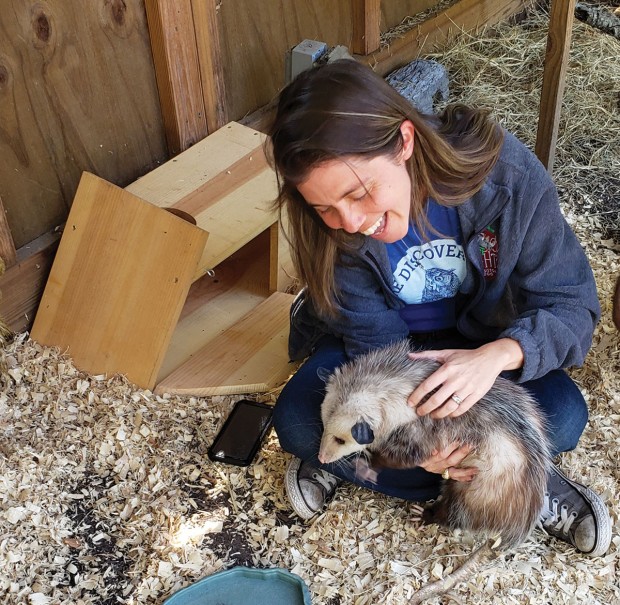
The Nature Discovery Center’s Blossom with executive director DeAndra Ramsey. (Photo: Nature Discovery Center)
They are not generally destructive. Like any small animal who gets stuck in a space, they might damage wiring. However, opossums, unlike raccoons and squirrels, don’t tear things apart. And the claws on their little pink toes are much like our own fingernails, too weak to dig and tear up your garden. Opossums are often blamed for things they didn’t start. It’s probably a raccoon who knocked over your garbage can even if there’s an opossum eating your trash when you discover it.
“They are little trashmen,” says Discovery Center’s Duran. They also eat cockroaches, snails, rats, and mice. Some scientists believe that the presence of opossums will cause the tick population in an area to plunge because, these scientists found, more than 95 percent of the ticks that land on opossums, who are fastidious groomers, get eaten.
Opossums also eat poisonous snakes and appear to be immune to the venom of pit vipers, including our rattlesnakes, copperheads, and cottonmouths.
Contrary to what you might think from looking at all the accounts featuring opossums on social media, opossums do not make good pets. (Some – like instagram account @itsmesesame – are run by licensed wildlife rehabilitators; not all of them are.) First of all, it is illegal to keep an opossum for a pet in the state of Texas because it is native wildlife. Second, it’s difficult to keep them healthy. They need a precise ratio of phosphorus to calcium in their diet or they develop a painful, crippling, and ultimately lethal condition called metabolic bone disease.
“On Mondays, Blossom gets smelt,” Samantha Norris, education manager of the Houston Humane Society Texas Wildlife Rehabilitation Center (TWRC), told me. Smelt is a small fish. Blossom is an “ambassador animal” for TWRC; she would not be able to survive in the wild because she only has one eye. She also eats specialized pellets made for omnivore zoo animals and a precisely scheduled diet of things ranging from quail eggs, a wide variety of fruits and vegetables, and low-fat mozzarella cheese to mice and live invertebrates.
The Nature Discovery Center in Bellaire also has an ambassador-animal opossum, theirs also coincidentally named Blossom, who also came via TWRC. Their Blossom can’t be released because she stayed too long in captivity and imprinted on humans; she is also mostly deaf.
Both Blossoms were found orphaned, too young to survive on their own. During the opossum “baby season,” from February through the spring, TWRC might have 100 to 150 orphaned opossums under its care at a time.
According to TWRC, if a baby opossum is less than seven inches long from snout to rump, not including its tail, it’s too young to be on its own. Otherwise, “if you see a baby opossum, but it’s walking around confidently, like it knows what it’s doing, it’s probably okay,” says the Discovery Center’s Duran, adding that, with wildlife, the best option is often to leave them alone. If you are unsure if a baby or an injured adult needs help, you can always call a wildlife rehabilitation center, such as TWRC (713-468-8972) or the Houston SPCA’s Wildlife Center of Texas (713-861-9453).
Samantha Norris of TWRC advises not to give an animal you find food or water before you bring it in.
Dead opossum females can often have babies in their pouches. Wildlife experts say you can look in her pouch to see, and Norris says you can bring the dead mother into TWRC and their staff will detach the babies. (Personally, I’d like to think I could do that, but I’d need to steel myself beforehand and probably have a lie-down after.)
Although, by law, professional pest-control companies are required to trap wildlife humanely and release them, wildlife experts say they prefer that animals like opossums not be brought to a distant area to be released because they may not be able to survive in an unfamiliar place.
What a wonder opossums are … especially when they’re not in your house or car.
Want more buzz like this? Sign up for our Morning Buzz emails.
To leave a comment, please log in or create an account with The Buzz Magazines, Disqus, Facebook, or Twitter. Or you may post as a guest.



